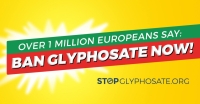Brussels, 19th July 2017 – Today, as regulators met at the EU Commission headquarters to discuss the future of Glyphosate – the most used, and possibly most controversial, herbicide active substance in the world – citizens and civil society organizations from all over Europe gathered in the square outside the Berlaymont complex in a symbolic stunt.
A giant replica of the most famous product containing Glyphosate (namely, Monsanto’s Roundup Ready herbicide) was toppled in order to send regulators inside the building a clear and strong message: namely, that Europeans are increasingly concerned about the effects of exposure to dangerous chemicals such as pesticides, and Glyphosate has been at the top of the list since 2015 when the WHO’s cancer research agency (IARC) classified it as “probably carcinogenic” to humans, sparking an ongoing, controversial debate in the international scientific community.
Conversely, the European Food Safety Authority (EFSA) and the European Chemicals Agency (ECHA) have said glyphosate doesn’t cause cancer in humans, but have pointed out to serious environmental damage caused by the chemical. EFSA is also currently assessing evidence that glyphosate disrupts the human hormone system.
Nonetheless, despite IARC’s ruling and the fact that the State of California has recently added Glyphosate to its list of cancer-causing chemicals, the European Commission is proposing to renew the license for Glyphosate by another 10 years.
The European Citizens’ Initiative to Stop Glyphosate emerged in February 2017 in reaction to the decision by EU authorities: so far, the ECI has been the fastest-growing ever, having fulfilled the validity requirements of 1,000,000 signatures from European citizens in just a few months. Its main demands are three: for the EU to put an end to the use of glyphosate-based products, to gradually reduce overall pesticide use (and move toward more sustainable farming measures) and make the safety assessment of pesticides completely transparent, based only on publicly available studies and being independent from the pesticide industry that has a commercial interest.
The final demand is especially significant. Aside from the long-standing debates over the carcinogenicity of glyphosate, there has been a strong criticism on how the safety assessment procedures have been influenced by industry-affiliated bodies. In fact, a group of ninety-six independent scientists have warned that the EFSA assessment is not supported by the evidence submitted, and that both EFSA and ECHA have failed to identify numerous tumour findings in the confidential, industry-submitted animal studies and committed serious scientific errors during their evaluation to arrive to the equivocal conclusion.
This resonates with information recently leaked from a California court case of more than 100 lawsuits against Monsanto Co., filed by people alleging that exposure to Roundup herbicide caused them or their loved ones to develop non-Hodgkin lymphoma. Internal e-mails show how the company has been aware of its top products’ carcinogenicity potential for decades, and has been covering this up in a number of ways, including ghost-writing scientific studies and pressuring safety assessment bodies through intense corporate lobbying and an unwritten ‘revolving-door’ policy.
